Ensemble Neural Networks for the Development of Storm Surge Flood Modeling: A Comprehensive Review
Abstract
1. Introduction
2. Neural Network Ensemble
3. Theoretical Framework
3.1. Neural Network Architectures
3.2. Transfer Learning
3.3. Ensemble Generation Methods
4. Ensemble Pruning and Fine-Tuning
5. Data Preparation
5.1. Raw Input Data
| Dataset | Description | Features | Source |
|---|---|---|---|
| North Atlantic Coast Comprehensive Study (NACCS) | A combined set of 1050 synthetic tropical and 100 synthetic extratropical storms using the coupled ADCIRC/STWAVE models | ✓ Consistent across the entire North Atlantic Coast region. | The U.S. Army Corps of Engineers (USACE) [146] |
| ✓ Covers storm surge, sea level rise, and erosion | |||
| ✓ Easily accessible | |||
| ✗ Coarse spatial resolution | |||
| ✗ Limited temporal scope | |||
| ✗ Relies on certain assumptions and uncertainties | |||
| ECMWF Re-Analysis (ERA5) | The latest generation of atmospheric reanalysis of the global climate with detailed information on a wide range of atmospheric variables. | ✓ High temporal and spatial resolution | Copernicus Climate Change Service (C3S), the joint C3S-NOAA project [147,148] |
| ✓ Covers a wide range of atmospheric variables | |||
| ✓ Publicly available | |||
| ✗ Complex and may require advanced technical skills | |||
| ✗ Limited vertical resolution (137 pressure levels) | |||
| Global Extreme Sea-Level Analysis Version 2 (GESLA-2) | Provides 39148 years of sea level data from 1355 station records, with information on extreme sea levels, including storm surges, tidal cycles, and rise in sea level. | ✓ Covers a wide range of extreme sea-level events | University of Hawaii and the National Oceanic and Atmospheric Administration (NOAA) [2] |
| ✓ Consistent across the entire globe and different geographic locations | |||
| ✓ Publicly available | |||
| ✗ Gaps in the data particularly for remote or sparsely populated regions. | |||
| ✗ Relies on certain assumptions and uncertainties | |||
| ✗ Limited information on coastal morphology and human activities | |||
| NOAA Global Real Time Ocean Forecasting System (RTOFS global | provides nowcasts (analyses of near-present conditions) and forecast guidance on up to eight days of ocean temperature and salinity, water velocity, sea surface elevation, sea ice coverage, and sea ice thickness. | ✓ Provides high-quality and updated oceanographic and meteorological data in real time | National Centers for Environmental Prediction (NCEP), NOAA [4] |
| ✓ Global coverage | |||
| ✓ High spatial and temporal resolution | |||
| ✓ Integration with other models for a more comprehensive understanding of storm surge | |||
| ✗ Limited data availability for a particular area or time period | |||
| ✗ Relies on certain assumptions and uncertainties | |||
| ✗ Requires significant computational resources | |||
| Coastal Hazards System (CHS) | National coastal storm hazard data resource for probabilistic coastal hazard assessment (PCHA) results and statistics, including measurements of water level, wind speed, and wave height | ✓ High-quality data | Pacific Coastal and Marine Science Center of the United States Geological Survey (USGS) [149] |
| ✓ High spatial resolution with detailed information about storm surge patterns | |||
| ✓ Provides historical data | |||
| ✗ Limited to the coastal areas of the United States | |||
| ✗ Limited temporal resolution for predicting a storm surge during an ongoing event | |||
| ✗ Needs to be integrated with other models to make accurate predictions | |||
| The Sea, Lake and Overland Surges from Hurricanes (SLOSH) model | Uses a combination of historical storm data, topographical data, and numerical algorithms to simulate the impact of a hurricane on coastal areas and predict storm surge heights and flooding potential associated with hurricanes. | ✓ Specifically designed and tested for storm surge prediction | National Oceanic and Atmospheric Administration (NOAA) [150] |
| ✓ Can be customized to specific geographic areas | |||
| ✓ Can be integrated with other models, such as atmospheric and wave models | |||
| ✗ Resource-intensive | |||
| ✗ Limited data availability (requires input data, such as atmospheric pressure and wind speed) | |||
| ✗ Limited spatial resolution | |||
| ✗ Relies on certain assumptions and uncertainties | |||
| National Water Level Observation Network (NWLON) | A network of tide gauges that can be used for storm surge prediction. | ✓ Specifically designed and tested for storm surge prediction | National Oceanic and Atmospheric Administration’s (NOAA) Center for Operational Oceanographic Products and Services (CO-OPS) [151] |
| ✓ Provides historical data | |||
| ✓ Wide geographic coverage throughout the United States | |||
| ✗ Limited spatial resolution | |||
| ✗ Lack of a comprehensive model for predicting storm surge (needs to be integrated with other models) | |||
| ✗ Limited data availability in all coastal regions |
5.2. Data Preprocessing and Wrangling
6. Model Selection and Evaluation
6.1. Bias–Variance Tradeoff
6.2. Ensemble Diversity
6.3. Probabilistic Performance
7. Summary
Author Contributions
Funding
Institutional Review Board Statement
Informed Consent Statement
Data Availability Statement
Conflicts of Interest
Appendix A. Implementation of Backward Propagation of Errors

- Defining the sigmoid activation function and its derivative
1 def activation(x):
2 return 1 / (1 + np.exp(-x))
3 def activation_derivative(x):
4 return activation(x) * (1 - activation(x))
- Defining the forward propagation function
1 def forward_propagation(x, weights, biases):
2 a = [x]3 z = []4 for l in range(1, len(weights) + 1):
5 z.append(np.dot(weights[l], a[l-1]) + biases[l])6 a.append(activation(z[l-1]))7 return a, z
- Defining the backward propagation function
1 def backward_propagation(x, y, a, z, weights, biases, learning_rate):
2 L = len(weights)3 delta = [None] * (L + 1)4 gradients = {}
- Running the error propagation using the chain rule , , and Loss Function
1 # Compute the output layer delta
2 delta[L] = (a[L] - y) * activation_derivative(z[L-1])3 # Compute deltas (*@\color{codegreen}\textbf{for}@*) the hidden layers
4 for l in range(L-1, 0, -1):
5 delta[l] = np.dot(weights[l+1].T, delta[l+1]) * activation_derivative(z[l-1])6 # Compute gradients (*@\color{codegreen}\textbf{for}@*) weights and biases
7 for l in range(1, L+1):
8 gradients[f’dW{l}’] = np.dot(delta[l], a[l-1].T)9 gradients[f’db{l}’] = delta[l]
References
- Heberger, M.; Cooley, H.; Herrera, P.; Gleick, P.H.; Moore, E. Potential impacts of increased coastal flooding in California due to sea-level rise. Clim. Chang. 2011, 109, 229–249. [Google Scholar] [CrossRef]
- Woodruff, J.D.; Irish, J.L.; Camargo, S.J. Coastal flooding by tropical cyclones and sea-level rise. Nature 2013, 504, 44–52. [Google Scholar] [CrossRef] [PubMed]
- Barooni, M.; Nezhad, S.K.; Ali, N.A.; Ashuri, T.; Sogut, D.V. Numerical study of ice-induced loads and dynamic response analysis for floating offshore wind turbines. Mar. Struct. 2022, 86, 103300. [Google Scholar] [CrossRef]
- Cahoon, D.R.; Hensel, P.F.; Spencer, T.; Reed, D.J.; McKee, K.L.; Saintilan, N. Coastal wetland vulnerability to relative sea-level rise: Wetland elevation trends and process controls. In Wetlands and Natural Resource Management; Springer: Berlin/Heidelberg, Germany, 2006; pp. 271–292. [Google Scholar]
- Dube, S.; Jain, I.; Rao, A.; Murty, T. Storm surge modelling for the Bay of Bengal and Arabian Sea. Nat. Hazards 2009, 51, 3–27. [Google Scholar] [CrossRef]
- Hashemi, M.R.; Spaulding, M.L.; Shaw, A.; Farhadi, H.; Lewis, M. An efficient artificial intelligence model for prediction of tropical storm surge. Nat. Hazards 2016, 82, 471–491. [Google Scholar] [CrossRef]
- Flowerdew, J.; Horsburgh, K.; Wilson, C.; Mylne, K. Development and evaluation of an ensemble forecasting system for coastal storm surges. Q. J. R. Meteorol. Soc. 2010, 136, 1444–1456. [Google Scholar] [CrossRef]
- Lynett, P.J.; Gately, K.; Wilson, R.; Montoya, L.; Arcas, D.; Aytore, B.; Bai, Y.; Bricker, J.D.; Castro, M.J.; Cheung, K.F.; et al. Inter-model analysis of tsunami-induced coastal currents. Ocean. Model. 2017, 114, 14–32. [Google Scholar] [CrossRef]
- Arabi, M.G.; Sogut, D.V.; Khosronejad, A.; Yalciner, A.C.; Farhadzadeh, A. A numerical and experimental study of local hydrodynamics due to interactions between a solitary wave and an impervious structure. Coast. Eng. 2019, 147, 43–62. [Google Scholar] [CrossRef]
- Al Kajbaf, A.; Bensi, M. Application of surrogate models in estimation of storm surge: A comparative assessment. Appl. Soft Comput. 2020, 91, 106184. [Google Scholar] [CrossRef]
- Qiao, C.; Myers, A.T.; Arwade, S.R. Validation and uncertainty quantification of metocean models for assessing hurricane risk. Wind. Energy 2020, 23, 220–234. [Google Scholar] [CrossRef]
- Arns, A.; Dangendorf, S.; Jensen, J.; Talke, S.; Bender, J.; Pattiaratchi, C. Sea-level rise induced amplification of coastal protection design heights. Sci. Rep. 2017, 7, 40171. [Google Scholar] [CrossRef]
- Weaver, R.J.; Slinn, D.N. Effect of wave forcing on storm surge. In Coastal Engineering 2004: (In 4 Volumes); World Scientific: Singapore, 2005; pp. 1532–1538. [Google Scholar]
- Sweet, W.V.; Kopp, R.E.; Weaver, C.P.; Obeysekera, J.; Horton, R.M.; Thieler, E.R.; Zervas, C. Global and Regional Sea Level Rise Scenarios for the United States; Technical Report; National Oceanic and Atmospheric Administration: Washington, DC, USA, 2017.
- Liu, Z.; Cheng, L.; Hao, Z.; Li, J.; Thorstensen, A.; Gao, H. A framework for exploring joint effects of conditional factors on compound floods. Water Resour. Res. 2018, 54, 2681–2696. [Google Scholar] [CrossRef]
- Xi, D.; Lin, N. Understanding uncertainties in tropical cyclone rainfall hazard modeling using synthetic storms. J. Hydrometeorol. 2022, 23, 925–946. [Google Scholar] [CrossRef]
- Dtissibe, F.Y.; Ari, A.A.A.; Titouna, C.; Thiare, O.; Gueroui, A.M. Flood forecasting based on an artificial neural network scheme. Nat. Hazards 2020, 104, 1211–1237. [Google Scholar] [CrossRef]
- Velioglu, D. Advanced Two-and Three-Dimensional Tsunami Models: Benchmarking and Validation. Ph.D. Thesis, Middle East Technical University, Ankara, Turkey, 2017. [Google Scholar]
- Chen, Y.; Li, J.; Xu, H. Improving flood forecasting capability of physically based distributed hydrological models by parameter optimization. Hydrol. Earth Syst. Sci. 2016, 20, 375–392. [Google Scholar] [CrossRef]
- Agudelo-Otálora, L.M.; Moscoso-Barrera, W.D.; Paipa-Galeano, L.A.; Mesa-Sciarrotta, C. Comparación de modelos físicos y de inteligencia artificial para predicción de niveles de inundación. Tecnol. Cienc. Agua 2018, 9, 209–235. [Google Scholar] [CrossRef]
- Zhang, Z.; Liang, J.; Zhou, Y.; Huang, Z.; Jiang, J.; Liu, J.; Yang, L. A multi-strategy-mode waterlogging-prediction framework for urban flood depth. Nat. Hazards Earth Syst. Sci. 2022, 22, 4139–4165. [Google Scholar] [CrossRef]
- Oddo, P.C.; Lee, B.S.; Garner, G.G.; Srikrishnan, V.; Reed, P.M.; Forest, C.E.; Keller, K. Deep uncertainties in sea-level rise and storm surge projections: Implications for coastal flood risk management. Risk Anal. 2020, 40, 153–168. [Google Scholar] [CrossRef]
- Ju, Y.; Lindbergh, S.; He, Y.; Radke, J.D. Climate-related uncertainties in urban exposure to sea level rise and storm surge flooding: A multi-temporal and multi-scenario analysis. Cities 2019, 92, 230–246. [Google Scholar] [CrossRef]
- Makris, C.V.; Tolika, K.; Baltikas, V.N.; Velikou, K.; Krestenitis, Y.N. The impact of climate change on the storm surges of the Mediterranean Sea: Coastal sea level responses to deep depression atmospheric systems. Ocean. Model. 2023, 181, 102149. [Google Scholar] [CrossRef]
- Camargo, S.J.; Barnston, A.G.; Zebiak, S.E. A statistical assessment of tropical cyclone activity in atmospheric general circulation models. Tellus A Dyn. Meteorol. Oceanogr. 2005, 57, 589–604. [Google Scholar] [CrossRef][Green Version]
- Tadesse, M.; Wahl, T.; Cid, A. Data-driven modeling of global storm surges. Front. Mar. Sci. 2020, 7, 260. [Google Scholar] [CrossRef]
- Bevacqua, E.; Maraun, D.; Vousdoukas, M.; Voukouvalas, E.; Vrac, M.; Mentaschi, L.; Widmann, M. Higher probability of compound flooding from precipitation and storm surge in Europe under anthropogenic climate change. Sci. Adv. 2019, 5, eaaw5531. [Google Scholar] [CrossRef]
- Jelesnianski, C.P. Numerical computations of storm surges without bottom stress. Mon. Weather Rev. 1966, 94, 379–394. [Google Scholar] [CrossRef]
- Kim, Y.H. Assessment of coastal inundation due to storm surge under future sea-level rise conditions. J. Coast. Res. 2020, 95, 845–849. [Google Scholar] [CrossRef]
- Seo, J.; Ku, H.; Cho, K.; Maeng, J.H.; Lee, H. Application of SLOSH in estimation of Typhoon-induced Storm Surges in the Coastal Region of South Korea. J. Coast. Res. 2018, 551–555. [Google Scholar] [CrossRef]
- Dietrich, J.C.; Tanaka, S.; Westerink, J.J.; Dawson, C.N.; Luettich, R.; Zijlema, M.; Holthuijsen, L.H.; Smith, J.; Westerink, L.; Westerink, H. Performance of the unstructured-mesh, SWAN+ ADCIRC model in computing hurricane waves and surge. J. Sci. Comput. 2012, 52, 468–497. [Google Scholar] [CrossRef]
- De Las Heras, M.; Burgers, G.; Janssen, P. Wave data assimilation in the WAM wave model. J. Mar. Syst. 1995, 6, 77–85. [Google Scholar] [CrossRef]
- Bender, C.; Smith, J.M.; Kennedy, A.; Jensen, R. STWAVE simulation of Hurricane Ike: Model results and comparison to data. Coast. Eng. 2013, 73, 58–70. [Google Scholar] [CrossRef]
- Booij, N.; Holthuijsen, L.; Ris, R. The “SWAN” wave model for shallow water. Coast. Eng. 1996, 668–676. [Google Scholar]
- Reffitt, M.; Orescanin, M.M.; Massey, C.; Raubenheimer, B.; Jensen, R.E.; Elgar, S. Modeling storm surge in a small tidal two-inlet system. J. Waterw. Port Coast. Ocean. Eng. 2020, 146, 04020043. [Google Scholar] [CrossRef]
- Ramos Valle, A.N.; Curchitser, E.N.; Bruyere, C.L.; Fossell, K.R. Simulating storm surge impacts with a coupled atmosphere-inundation model with varying meteorological forcing. J. Mar. Sci. Eng. 2018, 6, 35. [Google Scholar] [CrossRef]
- Lee, J.W.; Irish, J.L.; Bensi, M.T.; Marcy, D.C. Rapid prediction of peak storm surge from tropical cyclone track time series using machine learning. Coast. Eng. 2021, 170, 104024. [Google Scholar] [CrossRef]
- Smith, J.M.; Westerink, J.J.; Kennedy, A.B.; Taflanidis, A.A.; Cheung, K.F.; Smith, T.D. SWIMS Hawaii hurricane wave, surge, and runup inundation fast forecasting tool. In Proceedings of the Solutions to Coastal Disasters Conference, Anchorage, AK, USA, 25–29 June 2011; pp. 89–98. [Google Scholar]
- Torres, M.J.; Nadal-Caraballo, N.C.; Ramos-Santiago, E.; Campbell, M.O.; Gonzalez, V.M.; Melby, J.A.; Taflanidis, A.A. StormSim-CHRPS: Coastal Hazards Rapid Prediction System. J. Coast. Res. 2020, 95, 1320–1325. [Google Scholar] [CrossRef]
- Ishida, K.; Tsujimoto, G.; Ercan, A.; Tu, T.; Kiyama, M.; Amagasaki, M. Hourly-scale coastal sea level modeling in a changing climate using long short-term memory neural network. Sci. Total Environ. 2020, 720, 137613. [Google Scholar] [CrossRef] [PubMed]
- Tebaldi, C.; Ranasinghe, R.; Vousdoukas, M.; Rasmussen, D.; Vega-Westhoff, B.; Kirezci, E.; Kopp, R.E.; Sriver, R.; Mentaschi, L. Extreme sea levels at different global warming levels. Nat. Clim. Chang. 2021, 11, 746–751. [Google Scholar] [CrossRef]
- Ayyad, M.; Hajj, M.R.; Marsooli, R. Machine learning-based assessment of storm surge in the New York metropolitan area. Sci. Rep. 2022, 12, 19215. [Google Scholar] [CrossRef]
- Tiggeloven, T.; Couasnon, A.; van Straaten, C.; Muis, S.; Ward, P.J. Exploring deep learning capabilities for surge predictions in coastal areas. Sci. Rep. 2021, 11, 17224. [Google Scholar] [CrossRef] [PubMed]
- Žust, L.; Fettich, A.; Kristan, M.; Ličer, M. HIDRA 1.0: Deep-learning-based ensemble sea level forecasting in the northern Adriatic. Geosci. Model Dev. 2021, 14, 2057–2074. [Google Scholar] [CrossRef]
- Ho, F.P.; Myers, V.A. Joint probability method of tide frequency analysis applied to Apalachicola Bay and St. George Sound, Florida; U.S. Department of Commerce, National Oceanic and Atmospheric Administration, National Weather Service, Office of Hydrology: Washington, DC, USA, 1975; Volume 18.
- Feng, J.; Li, D.; Li, Y.; Liu, Q.; Wang, A. Storm surge variation along the coast of the Bohai Sea. Sci. Rep. 2018, 8, 11309. [Google Scholar] [CrossRef]
- Ramos-Valle, A.N.; Curchitser, E.N.; Bruyère, C.L.; McOwen, S. Implementation of an artificial neural network for storm surge forecasting. J. Geophys. Res. Atmos. 2021, 126, e2020JD033266. [Google Scholar] [CrossRef]
- Igarashi, Y.; Tajima, Y. Application of recurrent neural network for prediction of the time-varying storm surge. Coast. Eng. J. 2021, 63, 68–82. [Google Scholar] [CrossRef]
- Kim, S.W.; Lee, A.; Mun, J. A surrogate modeling for storm surge prediction using an artificial neural network. J. Coast. Res. 2018, 866–870. [Google Scholar] [CrossRef]
- Royston, S.; Lawry, J.; Horsburgh, K. A linguistic decision tree approach to predicting storm surge. Fuzzy Sets Syst. 2013, 215, 90–111. [Google Scholar] [CrossRef]
- Bezuglov, A.; Blanton, B.; Santiago, R. Multi-output artificial neural network for storm surge prediction in north carolina. arXiv 2016, arXiv:1609.07378. [Google Scholar]
- Bass, B.; Bedient, P. Surrogate modeling of joint flood risk across coastal watersheds. J. Hydrol. 2018, 558, 159–173. [Google Scholar] [CrossRef]
- Tadesse, M.G.; Wahl, T. A database of global storm surge reconstructions. Sci. Data 2021, 8, 125. [Google Scholar] [CrossRef]
- Palmer, M.; Domingues, C.; Slangen, A.; Dias, F.B. An ensemble approach to quantify global mean sea-level rise over the 20th century from tide gauge reconstructions. Environ. Res. Lett. 2021, 16, 044043. [Google Scholar] [CrossRef]
- Bruneau, N.; Polton, J.; Williams, J.; Holt, J. Estimation of global coastal sea level extremes using neural networks. Environ. Res. Lett. 2020, 15, 074030. [Google Scholar] [CrossRef]
- Chen, R.; Zhang, W.; Wang, X. Machine learning in tropical cyclone forecast modeling: A review. Atmosphere 2020, 11, 676. [Google Scholar] [CrossRef]
- De Oliveira, M.M.; Ebecken, N.F.F.; De Oliveira, J.L.F.; de Azevedo Santos, I. Neural network model to predict a storm surge. J. Appl. Meteorol. Climatol. 2009, 48, 143–155. [Google Scholar] [CrossRef]
- Taylor, A.A.; Glahn, B. Probabilistic guidance for hurricane storm surge. In Proceedings of the 19th Conference on Probability and Statistics, New Orleans, LA, USA, 21–24 January 2008; Volume 74. [Google Scholar]
- Feng, X.; Ma, G.; Su, S.F.; Huang, C.; Boswell, M.K.; Xue, P. A multi-layer perceptron approach for accelerated wave forecasting in Lake Michigan. Ocean. Eng. 2020, 211, 107526. [Google Scholar] [CrossRef]
- Deo, R.C.; Ghorbani, M.A.; Samadianfard, S.; Maraseni, T.; Bilgili, M.; Biazar, M. Multi-layer perceptron hybrid model integrated with the firefly optimizer algorithm for windspeed prediction of target site using a limited set of neighboring reference station data. Renew. Energy 2018, 116, 309–323. [Google Scholar] [CrossRef]
- Kulkarni, P.A.; Dhoble, A.S.; Padole, P.M. Deep neural network-based wind speed forecasting and fatigue analysis of a large composite wind turbine blade. Proc. Inst. Mech. Eng. Part C J. Mech. Eng. Sci. 2019, 233, 2794–2812. [Google Scholar] [CrossRef]
- Chattopadhyay, A.; Hassanzadeh, P.; Pasha, S. Predicting clustered weather patterns: A test case for applications of convolutional neural networks to spatio-temporal climate data. Sci. Rep. 2020, 10, 1317. [Google Scholar] [CrossRef] [PubMed]
- Luo, Y.; Feng, A.; Li, H.; Li, D.; Wu, X.; Liao, J.; Zhang, C.; Zheng, X.; Pu, H. New deep learning method for efficient extraction of small water from remote sensing images. PLoS ONE 2022, 17, e0272317. [Google Scholar] [CrossRef]
- Hunt, K.M.; Matthews, G.R.; Pappenberger, F.; Prudhomme, C. Using a long short-term memory (LSTM) neural network to boost river streamflow forecasts over the western United States. Hydrol. Earth Syst. Sci. 2022, 26, 5449–5472. [Google Scholar] [CrossRef]
- Zilong, T.; Yubing, S.; Xiaowei, D. Spatial-temporal wave height forecast using deep learning and public reanalysis dataset. Appl. Energy 2022, 326, 120027. [Google Scholar] [CrossRef]
- Varalakshmi, P.; Vasumathi, N.; Venkatesan, R. Tropical Cyclone prediction based on multi-model fusion across Indian coastal region. Prog. Oceanogr. 2021, 193, 102557. [Google Scholar] [CrossRef]
- Sagi, O.; Rokach, L. Ensemble learning: A survey. Wiley Interdiscip. Rev. Data Min. Knowl. Discov. 2018, 8, e1249. [Google Scholar] [CrossRef]
- Young, C.C.; Liu, W.C.; Hsieh, W.L. Predicting the water level fluctuation in an alpine lake using physically based, artificial neural network, and time series forecasting models. Math. Probl. Eng. 2015, 2015, 708204. [Google Scholar] [CrossRef]
- Kim, S.; Matsumi, Y.; Pan, S.; Mase, H. A real-time forecast model using artificial neural network for after-runner storm surges on the Tottori coast, Japan. Ocean. Eng. 2016, 122, 44–53. [Google Scholar] [CrossRef]
- Blake, E.S.; Zelinsky, D.A. National Hurricane Center Tropical Cyclone Report; Hurricane Harvey; National Hurricane Center, National Oceanographic and Atmospheric Association: Miami, FL, USA, 2017.
- Qin, Y.; Su, C.; Chu, D.; Zhang, J.; Song, J. A Review of Application of Machine Learning in Storm Surge Problems. J. Mar. Sci. Eng. 2023, 11, 1729. [Google Scholar] [CrossRef]
- Yu, Y.; Zhang, H.; Singh, V.P. Forward prediction of runoff data in data-scarce basins with an improved ensemble empirical mode decomposition (EEMD) model. Water 2018, 10, 388. [Google Scholar] [CrossRef]
- Le, X.H.; Ho, H.V.; Lee, G.; Jung, S. Application of long short-term memory (LSTM) neural network for flood forecasting. Water 2019, 11, 1387. [Google Scholar] [CrossRef]
- Liao, L.; Li, H.; Shang, W.; Ma, L. An empirical study of the impact of hyperparameter tuning and model optimization on the performance properties of deep neural networks. ACM Trans. Softw. Eng. Methodol. (TOSEM) 2022, 31, 1–40. [Google Scholar] [CrossRef]
- Victoria, A.H.; Maragatham, G. Automatic tuning of hyperparameters using Bayesian optimization. Evol. Syst. 2021, 12, 217–223. [Google Scholar] [CrossRef]
- Yu, T.; Zhu, H. Hyper-parameter optimization: A review of algorithms and applications. arXiv 2020, arXiv:2003.05689. [Google Scholar]
- Hu, C.; Wu, Q.; Li, H.; Jian, S.; Li, N.; Lou, Z. Deep learning with a long short-term memory networks approach for rainfall-runoff simulation. Water 2018, 10, 1543. [Google Scholar] [CrossRef]
- Zhang, X.q.; Jiang, S.q. Study on the application of BP neural network optimized based on various optimization algorithms in storm surge prediction. Proc. Inst. Mech. Eng. Part M J. Eng. Marit. Environ. 2022, 236, 539–552. [Google Scholar] [CrossRef]
- Lee, T.L. Back-propagation neural network for the prediction of the short-term storm surge in Taichung harbor, Taiwan. Eng. Appl. Artif. Intell. 2008, 21, 63–72. [Google Scholar] [CrossRef]
- Tsai, C.; You, C.; Chen, C. Storm-surge prediction at the Tanshui estuary: Development model for maximum storm surges. Nat. Hazards Earth Syst. Sci 2013, 1, 7333–7356. [Google Scholar]
- Alzubaidi, L.; Zhang, J.; Humaidi, A.J.; Al-Dujaili, A.; Duan, Y.; Al-Shamma, O.; Santamaría, J.; Fadhel, M.A.; Al-Amidie, M.; Farhan, L. Review of deep learning: Concepts, CNN architectures, challenges, applications, future directions. J. Big Data 2021, 8, 1–74. [Google Scholar] [CrossRef] [PubMed]
- Giffard-Roisin, S.; Yang, M.; Charpiat, G.; Kumler Bonfanti, C.; Kégl, B.; Monteleoni, C. Tropical cyclone track forecasting using fused deep learning from aligned reanalysis data. Front. Big Data 2020, 3, 1. [Google Scholar] [CrossRef]
- Wang, T.; Liu, T.; Lu, Y. A hybrid multi-step storm surge forecasting model using multiple feature selection, deep learning neural network and transfer learning. Soft Comput. 2023, 27, 935–952. [Google Scholar] [CrossRef]
- Weiss, K.; Khoshgoftaar, T.M.; Wang, D. A survey of transfer learning. J. Big Data 2016, 3, 1–40. [Google Scholar] [CrossRef]
- Wu, W.; Westra, S.; Leonard, M. A basis function approach for exploring the seasonal and spatial features of storm surge events. Geophys. Res. Lett. 2017, 44, 7356–7365. [Google Scholar] [CrossRef]
- Wolf, J.; Flather, R. Modelling waves and surges during the 1953 storm. Philos. Trans. R. Soc. A Math. Phys. Eng. Sci. 2005, 363, 1359–1375. [Google Scholar] [CrossRef] [PubMed]
- Feng, J.; von Storch, H.; Jiang, W.; Weisse, R. Assessing changes in extreme sea levels along the coast of C hina. J. Geophys. Res. Ocean. 2015, 120, 8039–8051. [Google Scholar] [CrossRef]
- Bloemendaal, N.; Haigh, I.D.; de Moel, H.; Muis, S.; Haarsma, R.J.; Aerts, J.C. Generation of a global synthetic tropical cyclone hazard dataset using STORM. Sci. Data 2020, 7, 40. [Google Scholar] [CrossRef]
- Adhikari, R.; Agrawal, R. A homogeneous ensemble of artificial neural networks for time series forecasting. arXiv 2013, arXiv:1302.6210. [Google Scholar]
- Guan, H.; Mokadam, L.K.; Shen, X.; Lim, S.H.; Patton, R. Fleet: Flexible efficient ensemble training for heterogeneous deep neural networks. Proc. Mach. Learn. Syst. 2020, 2, 247–261. [Google Scholar]
- Zhou, Z.H.; Zhou, Z.H. Ensemble Learning; Springer: Berlin/Heidelberg, Germany, 2021. [Google Scholar]
- Zhou, Z.H.; Wu, J.; Tang, W. Ensembling neural networks: Many could be better than all. Artif. Intell. 2002, 137, 239–263. [Google Scholar] [CrossRef]
- Ghojogh, B.; Crowley, M. The theory behind overfitting, cross validation, regularization, bagging, and boosting: Tutorial. arXiv 2019, arXiv:1905.12787. [Google Scholar]
- Brodeur, Z.P.; Herman, J.D.; Steinschneider, S. Bootstrap aggregation and cross-validation methods to reduce overfitting in reservoir control policy search. Water Resour. Res. 2020, 56, e2020WR027184. [Google Scholar] [CrossRef]
- Altman, N.; Krzywinski, M. Ensemble methods: Bagging and random forests. Nat. Methods 2017, 14, 933–935. [Google Scholar] [CrossRef]
- Dietterich, T.G. Ensemble methods in machine learning. In Proceedings of the Multiple Classifier Systems: First International Workshop, MCS 2000, Cagliari, Italy, 21–23 June 2000; pp. 1–15. [Google Scholar]
- Cassales, G.; Gomes, H.; Bifet, A.; Pfahringer, B.; Senger, H. Improving the performance of bagging ensembles for data streams through mini-batching. Inf. Sci. 2021, 580, 260–282. [Google Scholar] [CrossRef]
- Maxwell, A.E.; Warner, T.A.; Fang, F. Implementation of machine-learning classification in remote sensing: An applied review. Int. J. Remote Sens. 2018, 39, 2784–2817. [Google Scholar] [CrossRef]
- Zounemat-Kermani, M.; Batelaan, O.; Fadaee, M.; Hinkelmann, R. Ensemble machine learning paradigms in hydrology: A review. J. Hydrol. 2021, 598, 126266. [Google Scholar] [CrossRef]
- Elith, J.; Leathwick, J.R.; Hastie, T. A working guide to boosted regression trees. J. Anim. Ecol. 2008, 77, 802–813. [Google Scholar] [CrossRef]
- Freund, Y.; Schapire, R.E. A decision-theoretic generalization of on-line learning and an application to boosting. J. Comput. Syst. Sci. 1997, 55, 119–139. [Google Scholar] [CrossRef]
- Lawry, J.; He, H. Linguistic decision trees for fusing tidal surge forecasting models. In Combining Soft Computing and Statistical Methods in Data Analysis; Springer: Berlin/Heidelberg, Germany, 2010; pp. 403–410. [Google Scholar]
- Bentéjac, C.; Csörgo, A.; Martínez-Muñoz, G. A comparative analysis of gradient boosting algorithms. Artif. Intell. Rev. 2021, 54, 1937–1967. [Google Scholar] [CrossRef]
- Chen, T.; Guestrin, C. Xgboost: A scalable tree boosting system. In Proceedings of the 22nd ACM Sigkdd International Conference on Knowledge Discovery and Data Mining, San Francisco, CA, USA, 13–17 August 2016; pp. 785–794. [Google Scholar]
- Drucker, H. Improving regressors using boosting techniques. In Proceedings of the Fourteenth International Conference on Machine Learning (ICML 1997), Nashville, TN, USA, 8–12 July 1997; Volume 97, pp. 107–115. [Google Scholar]
- Muis, S.; Apecechea, M.I.; Dullaart, J.; de Lima Rego, J.; Madsen, K.S.; Su, J.; Yan, K.; Verlaan, M. A high-resolution global dataset of extreme sea levels, tides, and storm surges, including future projections. Front. Mar. Sci. 2020, 7, 263. [Google Scholar] [CrossRef]
- Sesmero, M.P.; Ledezma, A.I.; Sanchis, A. Generating ensembles of heterogeneous classifiers using stacked generalization. Wiley Interdiscip. Rev. Data Min. Knowl. Discov. 2015, 5, 21–34. [Google Scholar] [CrossRef]
- Barton, M.; Lennox, B. Model stacking to improve prediction and variable importance robustness for soft sensor development. Digit. Chem. Eng. 2022, 3, 100034. [Google Scholar] [CrossRef]
- Džeroski, S.; Ženko, B. Is combining classifiers with stacking better than selecting the best one? Mach. Learn. 2004, 54, 255–273. [Google Scholar] [CrossRef]
- Breiman, L. Stacked regressions. Mach. Learn. 1996, 24, 49–64. [Google Scholar] [CrossRef]
- Zucco, C. Multiple Learners Combination: Stacking. In Encyclopedia of Bioinformatics and Computational Biology; Ranganathan, S., Gribskov, M., Nakai, K., Schönbach, C., Eds.; Academic Press: Oxford, UK, 2019; pp. 536–538. [Google Scholar] [CrossRef]
- Sill, J.; Takács, G.; Mackey, L.; Lin, D. Feature-weighted linear stacking. arXiv 2009, arXiv:0911.0460. [Google Scholar]
- Young, S.; Abdou, T.; Bener, A. Deep super learner: A deep ensemble for classification problems. In Proceedings of the Advances in Artificial Intelligence: 31st Canadian Conference on Artificial Intelligence, Canadian AI 2018, Toronto, ON, Canada, 8–11 May 2018; pp. 84–95. [Google Scholar]
- Wolpert, D.H. Stacked generalization. Neural Netw. 1992, 5, 241–259. [Google Scholar] [CrossRef]
- Ayyad, M.; Orton, P.M.; El Safty, H.; Chen, Z.; Hajj, M.R. Ensemble forecast for storm tide and resurgence from Tropical Cyclone Isaias. Weather. Clim. Extrem. 2022, 38, 100504. [Google Scholar] [CrossRef]
- Kim, S.W.; Melby, J.A.; Nadal-Caraballo, N.C.; Ratcliff, J. A time-dependent surrogate model for storm surge prediction based on an artificial neural network using high-fidelity synthetic hurricane modeling. Nat. Hazards 2015, 76, 565–585. [Google Scholar] [CrossRef]
- Guo, T. Hurricane Damage Prediction based on Convolutional Neural Network Models. In Proceedings of the 2021 2nd International Conference on Artificial Intelligence and Computer Engineering (ICAICE), Hangzhou, China, 5–7 November 2021; pp. 298–302. [Google Scholar]
- Gebrehiwot, A.; Hashemi-Beni, L.; Thompson, G.; Kordjamshidi, P.; Langan, T.E. Deep convolutional neural network for flood extent mapping using unmanned aerial vehicles data. Sensors 2019, 19, 1486. [Google Scholar] [CrossRef]
- Accarino, G.; Chiarelli, M.; Fiore, S.; Federico, I.; Causio, S.; Coppini, G.; Aloisio, G. A multi-model architecture based on Long Short-Term Memory neural networks for multi-step sea level forecasting. Future Gener. Comput. Syst. 2021, 124, 1–9. [Google Scholar] [CrossRef]
- Kaur, S.; Gupta, S.; Singh, S.; Koundal, D.; Zaguia, A. Convolutional neural network based hurricane damage detection using satellite images. Soft Comput. 2022, 26, 7831–7845. [Google Scholar] [CrossRef]
- Korzh, O.; Joaristi, M.; Serra, E. Convolutional neural network ensemble fine-tuning for extended transfer learning. In Proceedings of the Big Data–BigData 2018: 7th International Congress, Held as Part of the Services Conference Federation, SCF 2018, Seattle, WA, USA, 25–30 June 2018; pp. 110–123. [Google Scholar]
- Becherer, N.; Pecarina, J.; Nykl, S.; Hopkinson, K. Improving optimization of convolutional neural networks through parameter fine-tuning. Neural Comput. Appl. 2019, 31, 3469–3479. [Google Scholar] [CrossRef]
- Blalock, D.; Gonzalez Ortiz, J.J.; Frankle, J.; Guttag, J. What is the state of neural network pruning? Proc. Mach. Learn. Syst. 2020, 2, 129–146. [Google Scholar]
- Araghinejad, S.; Azmi, M.; Kholghi, M. Application of artificial neural network ensembles in probabilistic hydrological forecasting. J. Hydrol. 2011, 407, 94–104. [Google Scholar] [CrossRef]
- Chen, W.; Hong, H.; Li, S.; Shahabi, H.; Wang, Y.; Wang, X.; Ahmad, B.B. Flood susceptibility modelling using novel hybrid approach of reduced-error pruning trees with bagging and random subspace ensembles. J. Hydrol. 2019, 575, 864–873. [Google Scholar] [CrossRef]
- Du, L.; Gao, R.; Suganthan, P.N.; Wang, D.Z. Bayesian optimization based dynamic ensemble for time series forecasting. Inf. Sci. 2022, 591, 155–175. [Google Scholar] [CrossRef]
- Pham, B.T.; Jaafari, A.; Nguyen-Thoi, T.; Van Phong, T.; Nguyen, H.D.; Satyam, N.; Masroor, M.; Rehman, S.; Sajjad, H.; Sahana, M.; et al. Ensemble machine learning models based on Reduced Error Pruning Tree for prediction of rainfall-induced landslides. Int. J. Digit. Earth 2021, 14, 575–596. [Google Scholar] [CrossRef]
- Rooney, N.; Patterson, D.; Nugent, C. Reduced ensemble size stacking [ensemble learning]. In Proceedings of the 16th IEEE International Conference on Tools with Artificial Intelligence, Boca Raton, FL, USA, 15–17 November 2004; pp. 266–271. [Google Scholar]
- Naftaly, U.; Intrator, N.; Horn, D. Optimal ensemble averaging of neural networks. Netw. Comput. Neural Syst. 1997, 8, 283. [Google Scholar] [CrossRef]
- Huang, W.; Hong, H.; Bian, K.; Zhou, X.; Song, G.; Xie, K. Improving deep neural network ensembles using reconstruction error. In Proceedings of the 2015 International Joint Conference on Neural Networks (IJCNN), Killarney, Ireland, 12–17 July 2015; pp. 1–7. [Google Scholar]
- Zeng, X.; Yeung, D.S. Hidden neuron pruning of multilayer perceptrons using a quantified sensitivity measure. Neurocomputing 2006, 69, 825–837. [Google Scholar] [CrossRef]
- Smith, C.; Jin, Y. Evolutionary multi-objective generation of recurrent neural network ensembles for time series prediction. Neurocomputing 2014, 143, 302–311. [Google Scholar] [CrossRef]
- Shahhosseini, M.; Hu, G.; Pham, H. Optimizing ensemble weights and hyperparameters of machine learning models for regression problems. Mach. Learn. Appl. 2022, 7, 100251. [Google Scholar] [CrossRef]
- Palaniswamy, S.K.; Venkatesan, R. Hyperparameters tuning of ensemble model for software effort estimation. J. Ambient. Intell. Humaniz. Comput. 2021, 12, 6579–6589. [Google Scholar] [CrossRef]
- Snoek, J.; Larochelle, H.; Adams, R.P. Practical bayesian optimization of machine learning algorithms. In Advances in Neural Information Processing Systems; Curran Associates, Inc.: Red Hook, NY, USA, 2012; Volume 25. [Google Scholar]
- Wu, J.; Chen, X.Y.; Zhang, H.; Xiong, L.D.; Lei, H.; Deng, S.H. Hyperparameter optimization for machine learning models based on Bayesian optimization. J. Electron. Sci. Technol. 2019, 17, 26–40. [Google Scholar]
- Priyadarshini, I.; Cotton, C. A novel LSTM–CNN–grid search-based deep neural network for sentiment analysis. J. Supercomput. 2021, 77, 13911–13932. [Google Scholar] [CrossRef] [PubMed]
- Huang, G.B.; Chen, L. Enhanced random search based incremental extreme learning machine. Neurocomputing 2008, 71, 3460–3468. [Google Scholar] [CrossRef]
- Agnihotri, A.; Batra, N. Exploring bayesian optimization. Distill 2020, 5, e26. [Google Scholar] [CrossRef]
- Zhou, J.; Peng, T.; Zhang, C.; Sun, N. Data pre-analysis and ensemble of various artificial neural networks for monthly streamflow forecasting. Water 2018, 10, 628. [Google Scholar] [CrossRef]
- Aloysius, N.; Geetha, M. A review on deep convolutional neural networks. In Proceedings of the 2017 International Conference on Communication and Signal Processing (ICCSP), Melmaruvathur, India, 6–8 April 2017; pp. 0588–0592. [Google Scholar]
- Kiranyaz, S.; Avci, O.; Abdeljaber, O.; Ince, T.; Gabbouj, M.; Inman, D.J. 1D convolutional neural networks and applications: A survey. Mech. Syst. Signal Process. 2021, 151, 107398. [Google Scholar] [CrossRef]
- Trice, A.; Robbins, C.; Philip, N.; Rumsey, M. Challenges and Opportunities for Ocean Data to Advance Conservation and Management; Ocean Conservancy: Washington, DC, USA, 2021. [Google Scholar]
- Velioglu Sogut, D.; Yalciner, A.C. Performance comparison of NAMI DANCE and FLOW-3D® models in tsunami propagation, inundation and currents using NTHMP benchmark problems. Pure Appl. Geophys. 2019, 176, 3115–3153. [Google Scholar] [CrossRef]
- Costa, W.; Idier, D.; Rohmer, J.; Menendez, M.; Camus, P. Statistical prediction of extreme storm surges based on a fully supervised weather-type downscaling model. J. Mar. Sci. Eng. 2020, 8, 1028. [Google Scholar] [CrossRef]
- Cialone, M.A.; Massey, T.C.; Anderson, M.E.; Grzegorzewski, A.S.; Jensen, R.E.; Cialone, A.; Mark, D.J.; Pevey, K.C.; Gunkel, B.L.; McAlpin, T.O.; et al. North Atlantic Coast Comprehensive Study (NACCS) Coastal Storm Model Simulations: Waves and Water Levels; US Army Engineer Research and Development Center, Coastal and Hydraulics Laboratory: Vicksburg, MS, USA, 2015. [Google Scholar]
- Yang, C.; Leonelli, F.E.; Marullo, S.; Artale, V.; Beggs, H.; Nardelli, B.B.; Chin, T.M.; De Toma, V.; Good, S.; Huang, B.; et al. Sea surface temperature intercomparison in the framework of the Copernicus Climate Change Service (C3S). J. Clim. 2021, 34, 5257–5283. [Google Scholar] [CrossRef]
- Hersbach, H. Decomposition of the continuous ranked probability score for ensemble prediction systems. Weather. Forecast. 2000, 15, 559–570. [Google Scholar] [CrossRef]
- Wallendorf, L.; Cox, D.T. Coastal Structures and Solutions to Coastal Disasters 2015: Tsunamis; American Society of Civil Engineers: Reston, VA, USA, 2017. [Google Scholar]
- Conver, A.; Sepanik, J.; Louangsaysongkham, B.; Miller, S. Sea, Lake, and Overland Surges from Hurricanes (SLOSH) Basin Development Handbook v2.0; NOAA/NWS/Meteorological Development Laboratory: Silver Springs, MD, USA, 2008.
- Miller, A.; Luscher, A. NOAA’s national water level observation network (NWLON). J. Oper. Oceanogr. 2019, 12, S57–S66. [Google Scholar] [CrossRef]
- Raschka, S. Python Machine Learning; Packt Publishing Ltd.: Birmingham, UK, 2015. [Google Scholar]
- Yang, H. Data preprocessing. In Data Mining: Concepts and Techniques; Pennsylvania State University, CiteSeerX: State College, PA, USA, 2018. [Google Scholar]
- Knapp, K.R.; Kruk, M.C.; Levinson, D.H.; Diamond, H.J.; Neumann, C.J. The International Best Track Archive for Climate Stewardship (IBTrACS). Bull. Am. Meteorol. Soc. 2010, 91, 363–376. [Google Scholar] [CrossRef]
- Knapp, K.R.; Diamond, H.J.; Kossin, J.P.; Kruk, M.C.; Schreck, C.J. International Best Track Archive for Climate Stewardship (IBTrACS) Project; Version 4; NOAA National Centers for Environmental Information: Asheville, NC, USA, 2018. [CrossRef]
- NOAA National Data Buoy Center. Meteorological and Oceanographic Data Collected from the National Data Buoy Center Coastal-Marine Automated Network (C-MAN) and Moored (Weather) Buoys; NOAA National Centers for Environmental Information, Dataset: Port Aransas, TX, USA, 1971.
- Adebisi, N.; Balogun, A.L.; Min, T.H.; Tella, A. Advances in estimating Sea Level Rise: A review of tide gauge, satellite altimetry and spatial data science approaches. Ocean. Coast. Manag. 2021, 208, 105632. [Google Scholar] [CrossRef]
- Kyprioti, A.P.; Taflanidis, A.A.; Plumlee, M.; Asher, T.G.; Spiller, E.; Luettich, R.A.; Blanton, B.; Kijewski-Correa, T.L.; Kennedy, A.; Schmied, L. Improvements in storm surge surrogate modeling for synthetic storm parameterization, node condition classification and implementation to small size databases. Nat. Hazards 2021, 109, 1349–1386. [Google Scholar] [CrossRef]
- Queipo, N.V.; Nava, E. A gradient boosting approach with diversity promoting measures for the ensemble of surrogates in engineering. Struct. Multidiscip. Optim. 2019, 60, 1289–1311. [Google Scholar] [CrossRef]
- Freeman, J.; Velic, M.; Colberg, F.; Greenslade, D.; Divakaran, P.; Kepert, J. Development of a tropical storm surge prediction system for Australia. J. Mar. Syst. 2020, 206, 103317. [Google Scholar] [CrossRef]
- Beuzen, T.; Goldstein, E.B.; Splinter, K.D. Ensemble models from machine learning: An example of wave runup and coastal dune erosion. Nat. Hazards Earth Syst. Sci. 2019, 19, 2295–2309. [Google Scholar] [CrossRef]
- Goodarzi, L.; Banihabib, M.E.; Roozbahani, A. A decision-making model for flood warning system based on ensemble forecasts. J. Hydrol. 2019, 573, 207–219. [Google Scholar] [CrossRef]
- Chang, L.C.; Amin, M.Z.M.; Yang, S.N.; Chang, F.J. Building ANN-based regional multi-step-ahead flood inundation forecast models. Water 2018, 10, 1283. [Google Scholar] [CrossRef]
- Neal, B.; Mittal, S.; Baratin, A.; Tantia, V.; Scicluna, M.; Lacoste-Julien, S.; Mitliagkas, I. A modern take on the bias-variance tradeoff in neural networks. arXiv 2018, arXiv:1810.08591. [Google Scholar]
- Ganaie, M.A.; Hu, M.; Malik, A.; Tanveer, M.; Suganthan, P. Ensemble deep learning: A review. Eng. Appl. Artif. Intell. 2022, 115, 105151. [Google Scholar] [CrossRef]
- James, G.; Witten, D.; Hastie, T.; Tibshirani, R. An Introduction to Statistical Learning; Springer: Berlin/Heidelberg, Germany, 2013; Volume 112. [Google Scholar]
- Ortega, L.A.; Cabañas, R.; Masegosa, A. Diversity and generalization in neural network ensembles. In Proceedings of the International Conference on Artificial Intelligence and Statistics, Valencia, Spain, 28–30 March 2022; pp. 11720–11743. [Google Scholar]
- Tsymbal, A.; Pechenizkiy, M.; Cunningham, P. Diversity in search strategies for ensemble feature selection. Inf. Fusion 2005, 6, 83–98. [Google Scholar] [CrossRef]
- Dutta, H. Measuring Diversity in Regression Ensembles. In Proceedings of the ICAI, Las Vegas, NV, USA, 13–16 July 2009; Volume 9, p. 17. [Google Scholar]
- Horsburgh, K.; Flowerdew, J. Real-Time Coastal Flood Forecasting. In Applied Uncertainty Analysis for Flood Risk Management; World Scientific Publishing Co., Pte. Ltd.: London, UK, 2014; pp. 538–562. [Google Scholar]
- Murphy, A.H. Skill scores based on the mean square error and their relationships to the correlation coefficient. Mon. Weather Rev. 1988, 116, 2417–2424. [Google Scholar] [CrossRef]
- Tonani, M.; Pinardi, N.; Fratianni, C.; Pistoia, J.; Dobricic, S.; Pensieri, S.; De Alfonso, M.; Nittis, K. Mediterranean Forecasting System: Forecast and analysis assessment through skill scores. Ocean. Sci. 2009, 5, 649–660. [Google Scholar] [CrossRef]
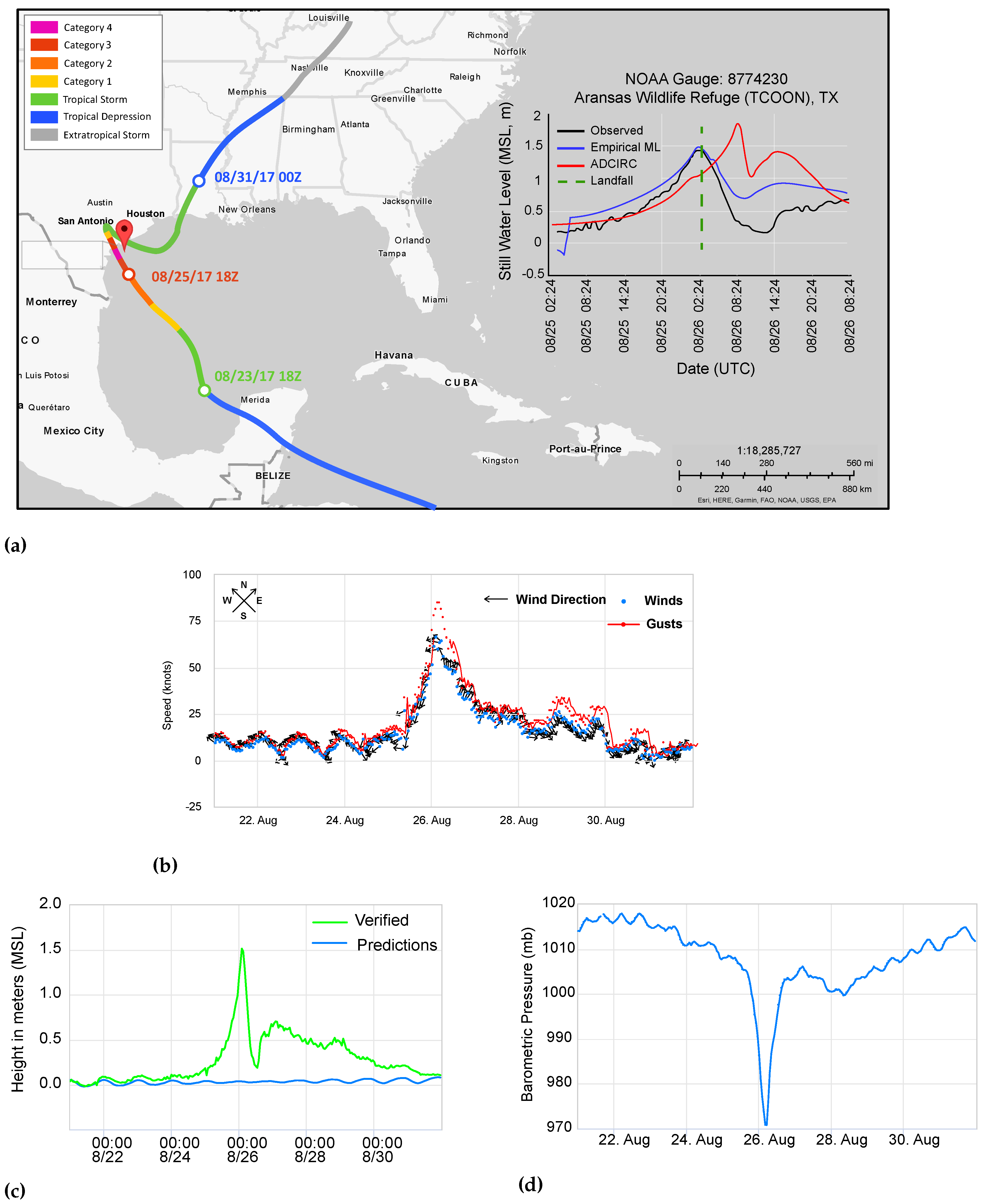

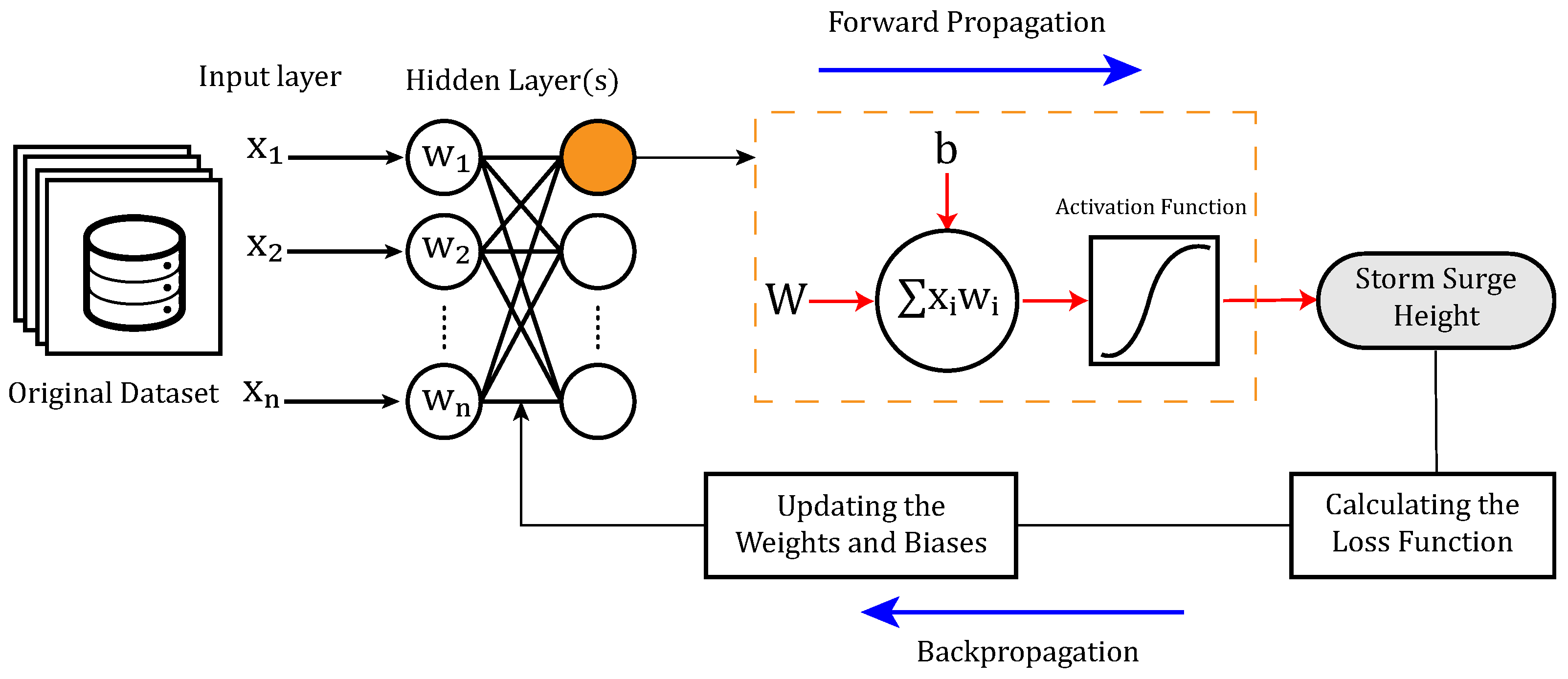
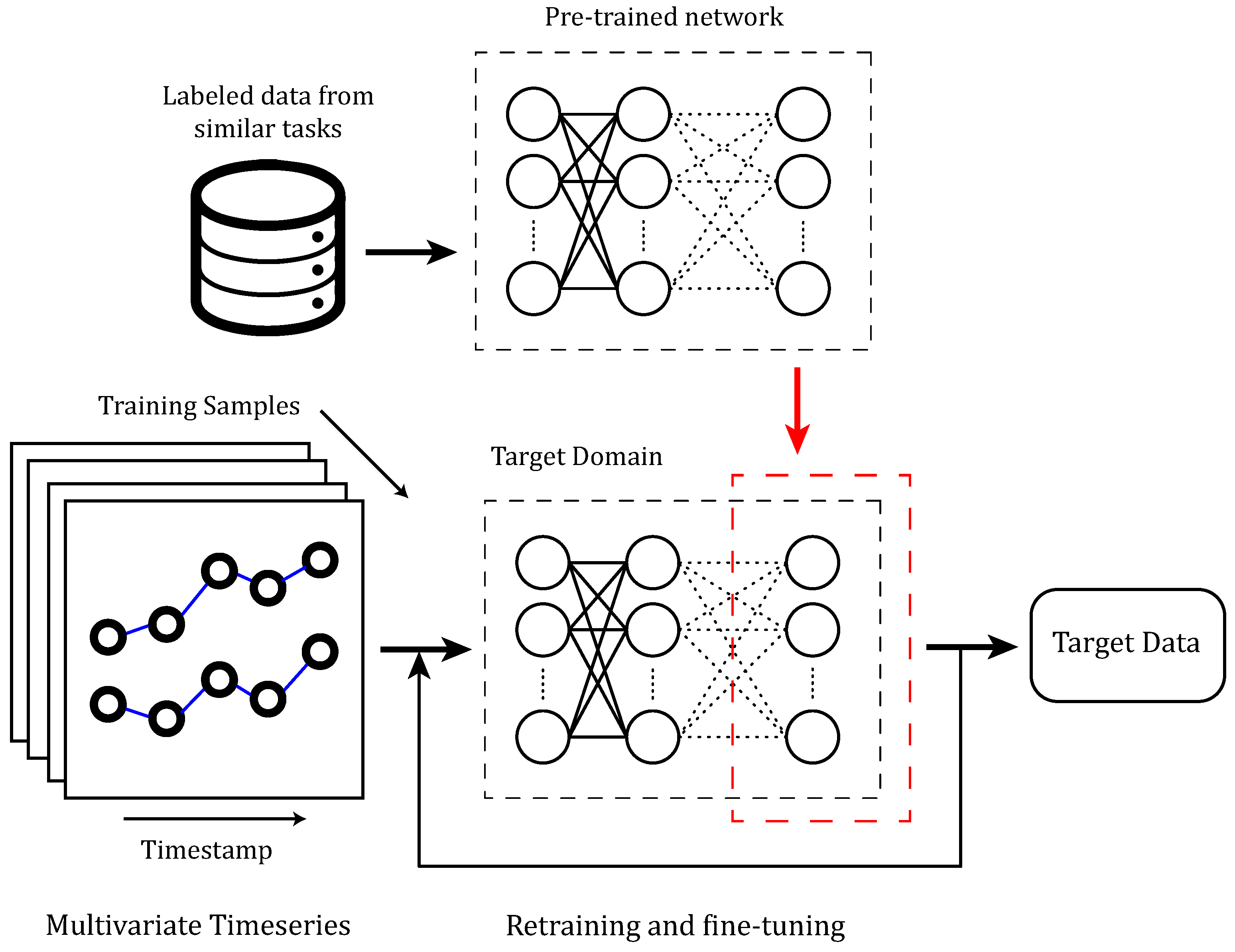
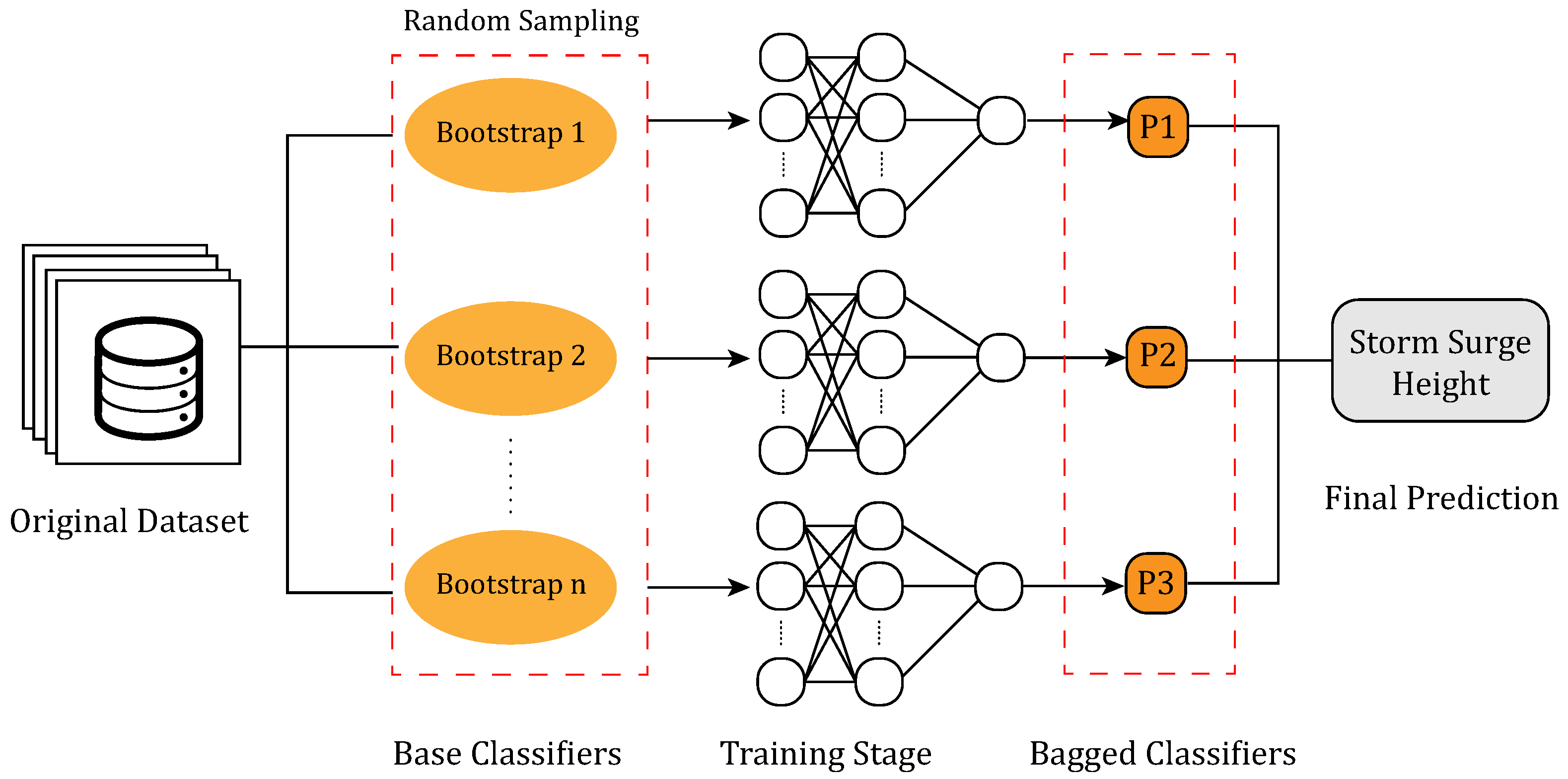
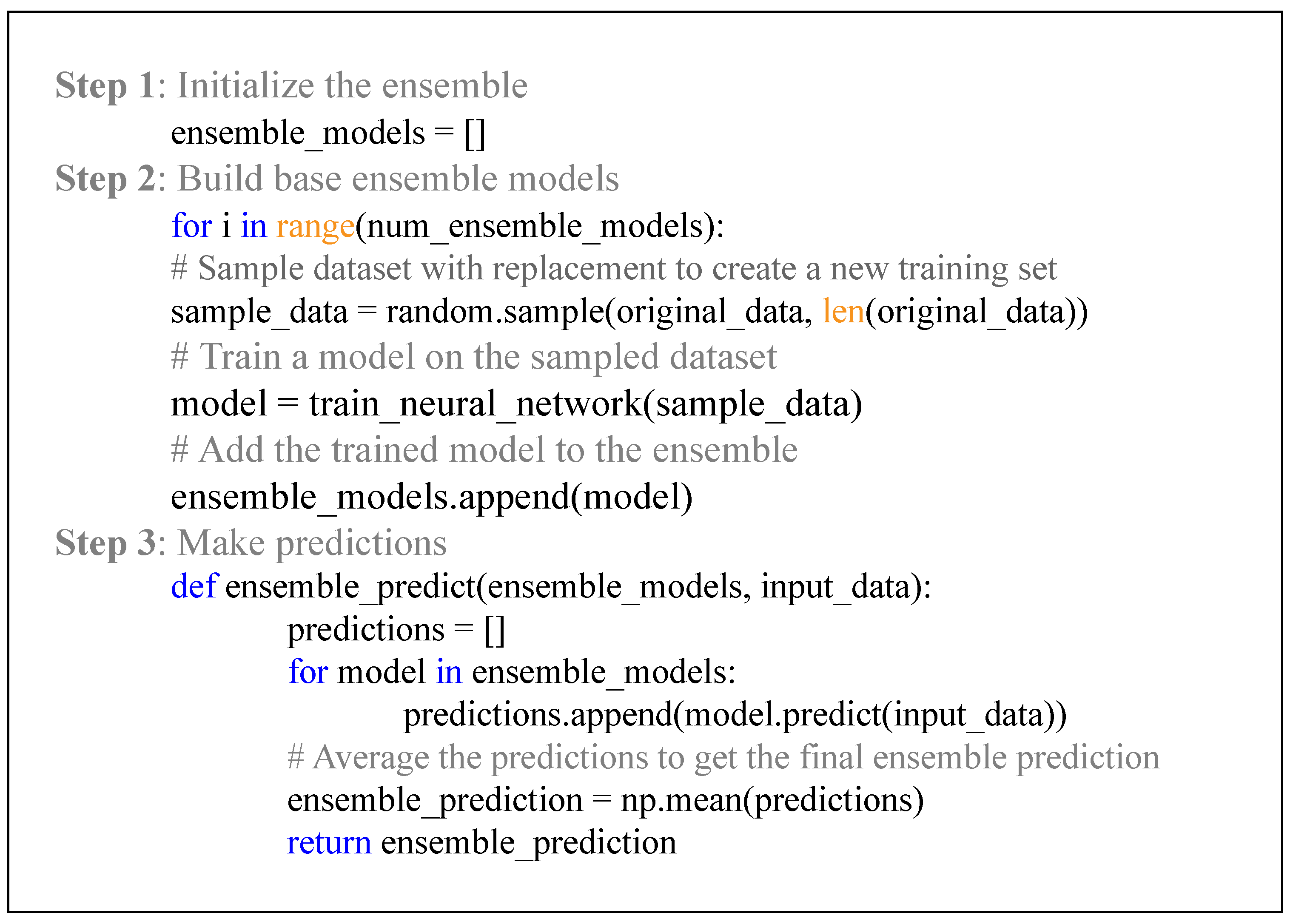
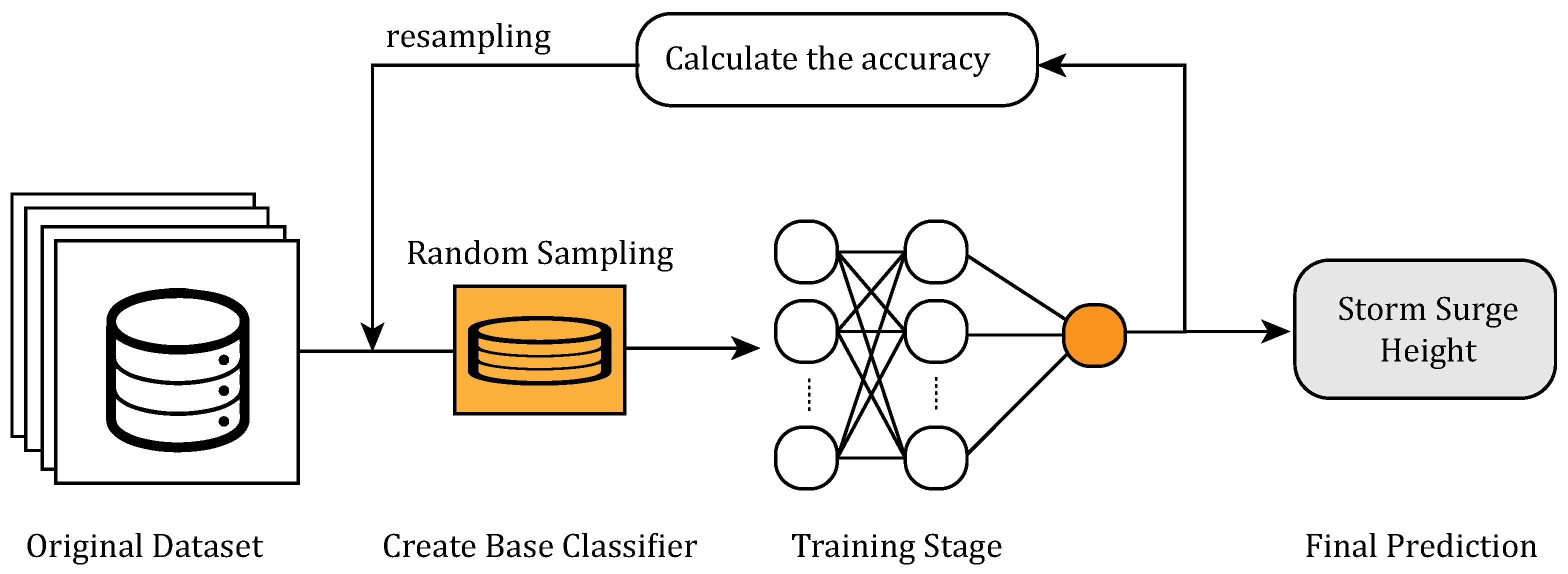

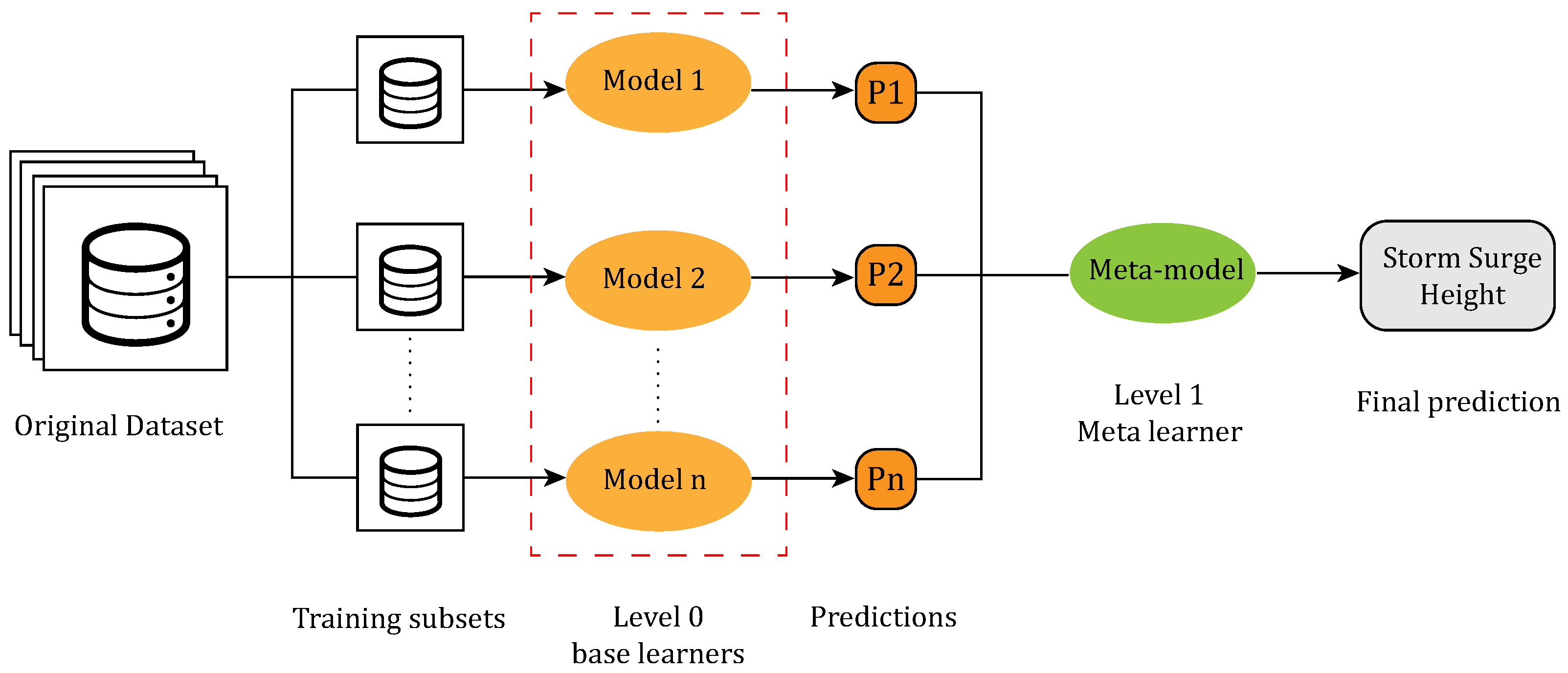
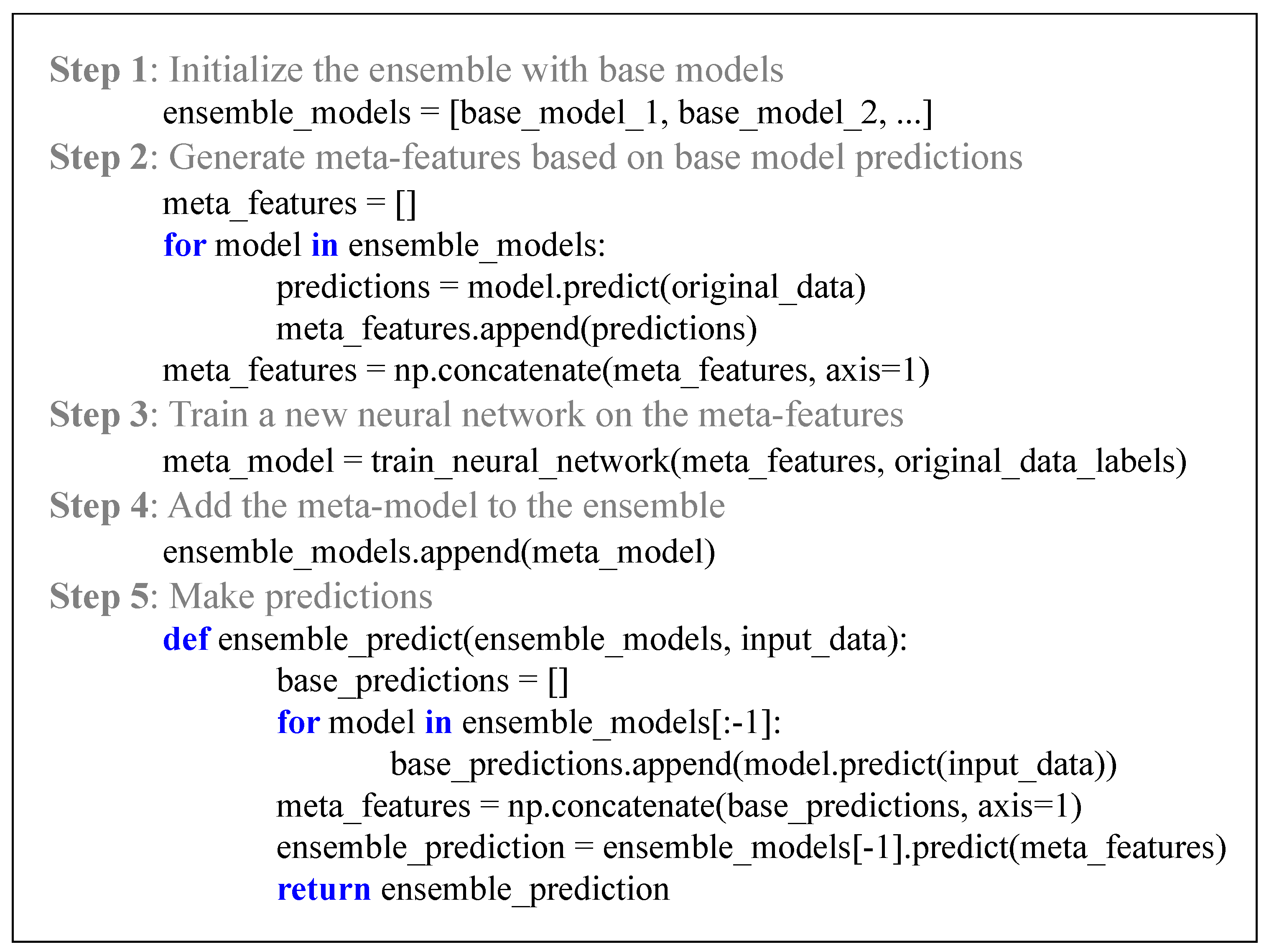

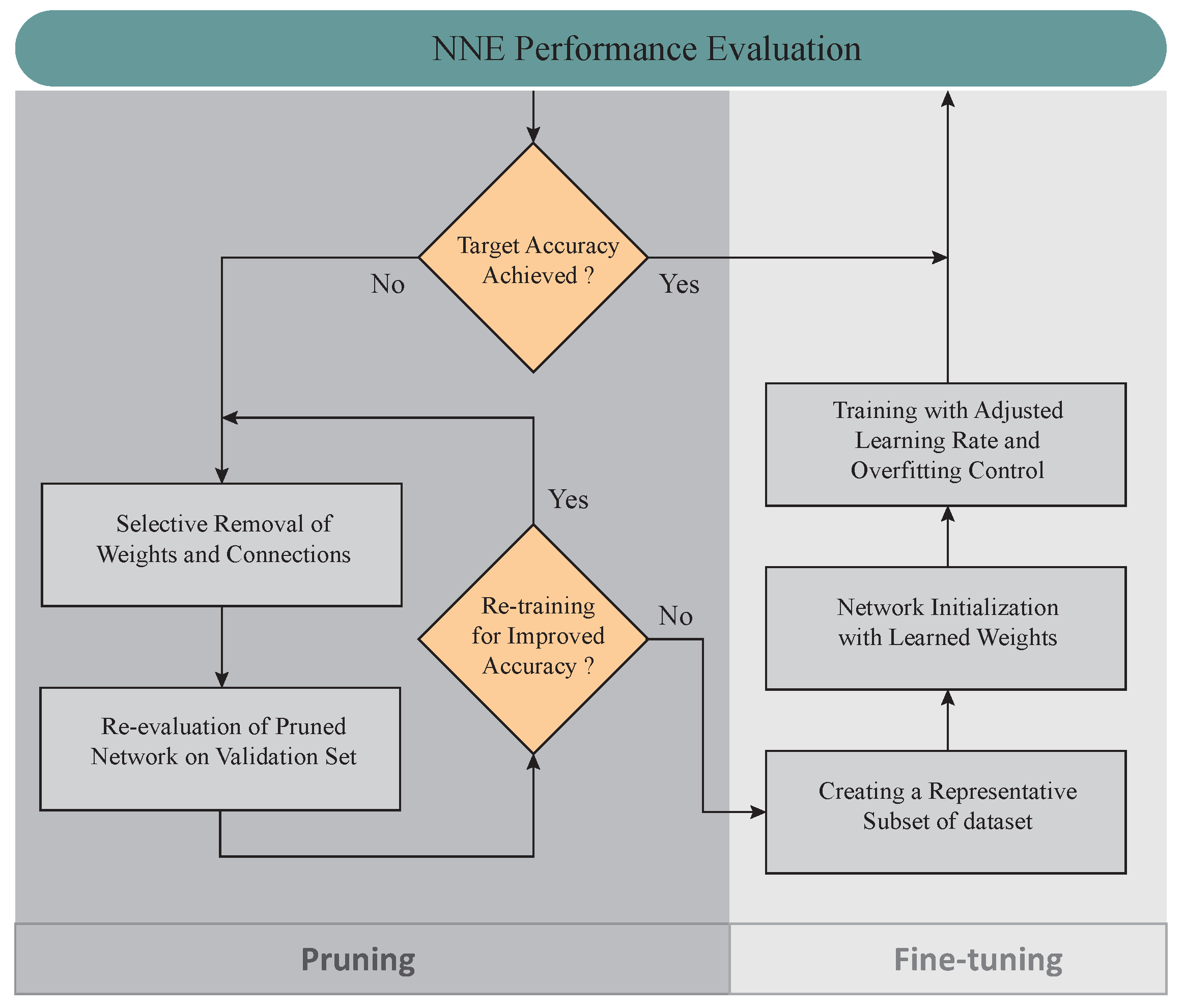
| Activation Function | Equation | Python Library | Applications |
|---|---|---|---|
| ReLU (Rectified Linear Unit) | tensorflow, keras | MLP, CNN | |
| Sigmoid | tensorflow, keras | RNN | |
| Tanh (Hyperbolic Tangent) | tensorflow, keras | RNN | |
| Softmax | tensorflow, keras | Classification, normalizing the output | |
| Leaky ReLU | tensorflow, keras | MLP, CNN |
| Physical Components | Training/Optimization Procedures | Regularization |
|---|---|---|
| Number of hidden layers within the network | Defining the optimizer algorithm | Degree of regularization (lambda) |
| Number of hidden Neurons | Configuring the learning rate | Number of active neurons (dropout rate) |
| Choice of key activation function | Defining the main type of loss function | |
| Choice of evaluation metric for regression problem | ||
| Number of training samples (mini-batch) | ||
| Setting the random initialization | ||
| Number of training cycles (epochs) |
| Study Number | Target Goal | Methodology | Ensemble Approach | Evaluation Metric | Data Collection |
|---|---|---|---|---|---|
| 1 [42] | Low-probability peak storm surge height due to TCs | ANN and coupled ADCIRC + SWAN simulations | GBDTR and AdaBoost Regressor | RAE, MRAE, and RMSE | Synthetic TCs + Historical typhoon data in the New York metropolitan area |
| 2 [115] | Storm tide and resurgence | Hydrodynamic and Hydrologic Ensemble Forecast | Stacking (super-ensemble) based on RMSE and bias correction | RMSE, PRE, and COU | US mid-Atlantic and Northeast coastline wind and tide data |
| 3 [43] | Hourly surge time series at the global scale | ANN, CNN, LSTM, and ConvLSTM | Bootstrap aggregation | RMSE and CRPS | GESLA Version 2 tide station database |
| 4 [37] | Peak storm surges from TC track time series | C1PKNet (1D CNN, principal component analysis, and k-means clustering) | Average of ten trained C1PKNet model predictions | MSE and CC | NACCS synthetic TC surge database |
| 5 [83] | Real time and accurate storm surge | CNN and LSTM, transfer learning | – | RMSE, MAE, and CC | Storm surge level time series in the southeastern coastal region of China |
| 6 [116] | Rapid prediction of storm surge time series | ANN and CSTORM-MS coupled model | – | RMSE and CC | Synthetic storms in the Gulf of Mexico |
| NACCS | ERA5 | GESLA2 | RTOFS | CHS | SLOSH | NWLON | |
|---|---|---|---|---|---|---|---|
| Spatial resolution | 0.25 degrees | 0.25 degrees | 0.25 degrees | 0.08 to 0.25 degrees | 0.02 to 0.05 degrees | 0.02 to 0.05 degrees | 0.08 to 0.33 degrees |
| Temporal resolution | 6 h | Hourly | Monthly | Hourly | Hourly | Hourly | Hourly |
| Coverage | North Atlantic Coast region | Global | Global | Global | Coastal areas of the United States | Atlantic and Gulf coasts of the United States | Coastal areas of the United States |
| Availability | Open access | Open access (needs license for real-time products) | Open access | Open access | Limited access | Limited access | Open access |
| Complexity | Highly complex | Highly complex | Complex | Complex | Fairly complex | Complex | Fairly complex |
| Possible data gap | Incomplete coverage or missing data for certain time periods | Missing or incomplete weather station data in certain regions or periods | Limited or no data on certain sea levels and time periods | Incomplete coverage or missing data for certain time periods | Incomplete coverage or missing data for certain time periods | Missing or incomplete data for certain hurricanes or regions | Incomplete coverage or missing data for certain time periods |
| Integration with other models | ✓ | ✗ | ✓ | ✓ | ✓ | ✓ | ✓ |
| SID | ISO_TIME | NATURE | LAT | LON | WMO_WIND | WMO_PRES | DIST2LAND | LANDFALL |
|---|---|---|---|---|---|---|---|---|
| degrees_N | degrees_E | kts | mb | km | km | |||
| 2017228N14314 | 8/25/2017 3:00 | TS | 25.2924 | −94.7578 | 243 | 204 | ||
| 2017228N14314 | 8/25/2017 6:00 | TS | 25.6 | −95.1 | 90 | 966 | 204 | 170 |
| 2017228N14314 | 8/25/2017 9:00 | TS | 25.935 | −95.4651 | 160 | 133 | ||
| 2017228N14314 | 8/25/2017 12:00 | TS | 26.3 | −95.8 | 95 | 949 | 133 | 123 |
| 2017228N14314 | 8/25/2017 15:00 | TS | 26.6999 | −96.0652 | 126 | 108 | ||
| 2017228N14314 | 8/25/2017 18:00 | TS | 27.1 | −96.3 | 105 | 943 | 108 | 67 |
| 2017228N14314 | 8/25/2017 21:00 | TS | 27.4875 | −96.5806 | 67 | 34 | ||
| 2017228N14314 | 8/26/2017 0:00 | TS | 27.8 | −96.8 | 115 | 941 | 34 | 11 |
| 2017228N14314 | 8/26/2017 3:00 | TS | 28 | −96.9 | 115 | 937 | 11 | 0 |
| 2017228N14314 | 8/26/2017 6:00 | TS | 28.2 | −97.1 | 105 | 948 | 0 | 0 |
| 2017228N14314 | 8/26/2017 9:00 | TS | 28.4534 | −97.2205 | 0 | 0 |
Disclaimer/Publisher’s Note: The statements, opinions and data contained in all publications are solely those of the individual author(s) and contributor(s) and not of MDPI and/or the editor(s). MDPI and/or the editor(s) disclaim responsibility for any injury to people or property resulting from any ideas, methods, instructions or products referred to in the content. |
© 2023 by the authors. Licensee MDPI, Basel, Switzerland. This article is an open access article distributed under the terms and conditions of the Creative Commons Attribution (CC BY) license (https://creativecommons.org/licenses/by/4.0/).
Share and Cite
Nezhad, S.K.; Barooni, M.; Velioglu Sogut, D.; Weaver, R.J. Ensemble Neural Networks for the Development of Storm Surge Flood Modeling: A Comprehensive Review. J. Mar. Sci. Eng. 2023, 11, 2154. https://doi.org/10.3390/jmse11112154
Nezhad SK, Barooni M, Velioglu Sogut D, Weaver RJ. Ensemble Neural Networks for the Development of Storm Surge Flood Modeling: A Comprehensive Review. Journal of Marine Science and Engineering. 2023; 11(11):2154. https://doi.org/10.3390/jmse11112154
Chicago/Turabian StyleNezhad, Saeid Khaksari, Mohammad Barooni, Deniz Velioglu Sogut, and Robert J. Weaver. 2023. "Ensemble Neural Networks for the Development of Storm Surge Flood Modeling: A Comprehensive Review" Journal of Marine Science and Engineering 11, no. 11: 2154. https://doi.org/10.3390/jmse11112154
APA StyleNezhad, S. K., Barooni, M., Velioglu Sogut, D., & Weaver, R. J. (2023). Ensemble Neural Networks for the Development of Storm Surge Flood Modeling: A Comprehensive Review. Journal of Marine Science and Engineering, 11(11), 2154. https://doi.org/10.3390/jmse11112154







